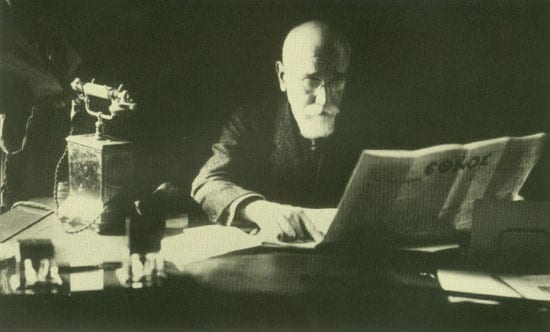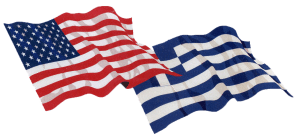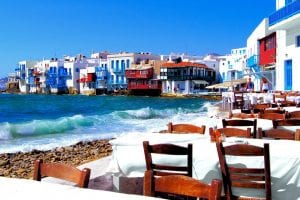BY PETER TSOURAS, HISTORYNET
The bitter struggle that created modern Greece and Turkey.
Since the fall of Constantinople to Ottoman Turks in 1453, the dream of Greeks had been to recover all Greek inhabited lands held by the Turks – European Greece, the Aegean Islands, western and northern Anatolia, even Constantinople itself. After Greece’s 1821-28 war of independence, the country more than doubled its size by reclaiming Greek lands from the Ottomans. This gathering in of Greek lands became known as the “Megali Idea” (Great Idea).
The man who most enthusiastically articulated the Megali Idea was the brilliant politician Eleuthérios Venizelos, who led Greece to victories in the 1912-13 Balkan Wars. He saw World War I as a golden opportunity and pressed for Greece to enter the war on the Allies’ side. The British even offered Cyprus as an inducement and promised Greece help in seizing Aegean Islands and southwestern Anatolia. Venizelos, how ever, was opposed by Greece’s King Constantine I. Although equally desirous of adding territory, Constantine was loath to enter so risky an alliance, especially one directed against his German relatives.
Meanwhile, the Ottomans were ethnically cleansing western Anatolia of Greeks. Villages and towns were forcibly evacuated, and their Greek inhabitants were marched to death into the desolate interior. Many Greek men were drafted into labor battalions and worked to death. The Ottoman Turks’ persecution of Greeks was of the same piece as their 1915 Armenian genocide – designed to rid Anatolia of its non-Turkish Christian populations.
In 1917, the Allies forced the abdication of King Constantine, replacing him with his son Alexander. King Alexander advocated the Megali Idea and returned Venizelos to power. Greece joined the Allies, but the disruptive events poisoned Greek domestic politics, dividing the country between royalists and Venizelists. At the 1919 Versailles Peace Conference, Venizelos obtained British support for Greek claims in the Aegean Islands and western Anatolia, particularly Smyrna (today Izmir), a Greek city since ancient times but under control of the Ottoman Empire since 1330 A.D.
Greek forces occupied Smyrna in May 1919, to the joy of its majority Greek and Armenian population. Encouraged by British Prime Minister Lloyd George, in 1920 the Greeks pushed farther into Anatolia to give strategic depth to their occupation. In October, however, King Alexander suddenly died of sepsis contracted from a monkey bite. The unusual accident changed Greek history. In the greatest mistake of an otherwise brilliant career, Venizelos rashly called an election and was decisively repudiated by an increasingly war-weary Greek electorate. Constantine, brought back from exile, immediately dismissed veteran army commanders and replaced them with royalist mediocrities while appointing Dimitrios Gounaris prime minister.
The Turks had not been inactive. Humiliations dealt by the Allies and the Greek invasion had galvanized Turks into patriotic resistance. The best of the Ottoman Empire’s generals, Mustafa Kemal, quickly rose to lead a reborn Turkish army. (See Cover Story, May 2010 ACG.) Bolshevik Russia’s Vladimir Lenin, hoping to bring Turkey into the socialist camp, poured arms, supplies and gold into the hands of Turkish nationalists. Italians, bitter that Greece had seized Smyrna (which Italy claimed), also began supplying the Turks.
In December 1920, the Greeks widened their occupation zone by attacking from Smyrna and a northwestern Anatolian enclave. The next year, they attacked again under the command of General Anastasios Papoulas but suffered reverses at the two battles of Inönü (January and March 1921). In summer 1921, the Greeks resumed their offensive to cut Turkey in two by severing rail links between the coast and the interior.A Greek army (nine divisions) decisively beat the Turks under General Mustafa Ismet Inönü (Ismet Pasha) at the Battle of Kütahya-Eskisehir but failed to press the routed Turks – a critical error. Instead, King Constantine, his ministers and generals argued over what to do next. Fatefully, they chose to press on to Ankara, the new Turkish capital, for a final showdown. The month’s hesitation, however, gave the Turks time to stiffen their defenses.
The campaign began with the decisive defeat of the Turks at the July 16-17 Battle of Karahisar. Ismet Pasha wanted to fight it out, but Mustafa Kemal prudently advised retiring to the Sakarya (Sangarios) River, 50 miles west of Ankara.
The Greeks by then were in a very favorable position,but the army’s leaders could not resist trying for a knockout blow. They marched their army into the bleak terrain of the interior,putting enormous strain on logistics and morale.Beginning August 21,a three-week battle was fought on the Sakarya. Papoulas now faced the redoubtable Turkish General Mustafa Fevzi Çakmak,with Kemal in overall charge. The seesaw battle ended in a tactical draw, although the Greeks inflicted 38,461 Turkish casualties against Greek losses of 23,067.Kemal assumed personal command and attempted to turn the Greek flank. This maneuver so alarmed King Constantine that he demanded that the battle be broken off.Papoulas obeyed, ordering a retreat that left behind nothing but scorched earth.
In 1922, Kemal was ready to launch his great offensive. Greek morale was faltering – the Allies had abandoned the Greeks and the fighting seemed endless. Papoulas had been fired and replaced by the even more incompetent General Georgios Hatzianestis. Kemal attacked on August 26 and broke the Greeks at the Battle of Dumlupınar, inflicting almost 50,000 losses at a cost of less than 15,000. The Turks pursued the retreating Greeks to Smyrna, where the last Greek army survivors were evacuated September 16.
Smyrna’s fate at the hands of the Turks was akin to the infamous 1937 Japanese Rape of Nanking.As many as 100,000 of Smyrna’s majority Greek and Armenian population were massacred, and much of the city was burned to the ground. Smyrna’s Greek Orthodox Archbishop forgave the Turks even as they tore him to pieces. Allied warships in Smyrna harbor were under orders to offer no assistance to the crowds of panic-stricken civilian refugees who crammed the docks, and the Turks butchered the terrified civilians.The horror of Smyrna killed the dream of the Megali Idea in a blood-soaked nightmare.
Led by Venizelist officers, the Greek army overthrew the government, tried those it held responsible for what became known in Greek history as the “Katástrophia,” and hanged six ousted leaders including Prime Minister Gounaris and General Hatzianestis. In July 1923, reinstated Prime Minister Venizelos and Mustafa Kemal (by then hailed as Atatürk, father and savior of his country) signed the Treaty of Lausanne. Its terms completed the ethnic cleansing of Turkey begun during World War I by exchanging the surviving Greek Orthodox Christians in Turkey for the Muslims living in Greece – almost 1.5 million Greeks and a half million Turks were made refugees. The treaty ended the Greek presence in Asia Minor that had begun in the ancient Trojan War and left both countries with largely homogeneous populations. There have been no more wars.
Peter Tsouras is the author of 26 books on military history. He has served in the Army and Army Reserve and worked for the Defense Intelligence Agency until retiring in 2010 to devote himself to writing, his roses, and his grandchildren.
Originally published in the January 2013 issue of Armchair General.









